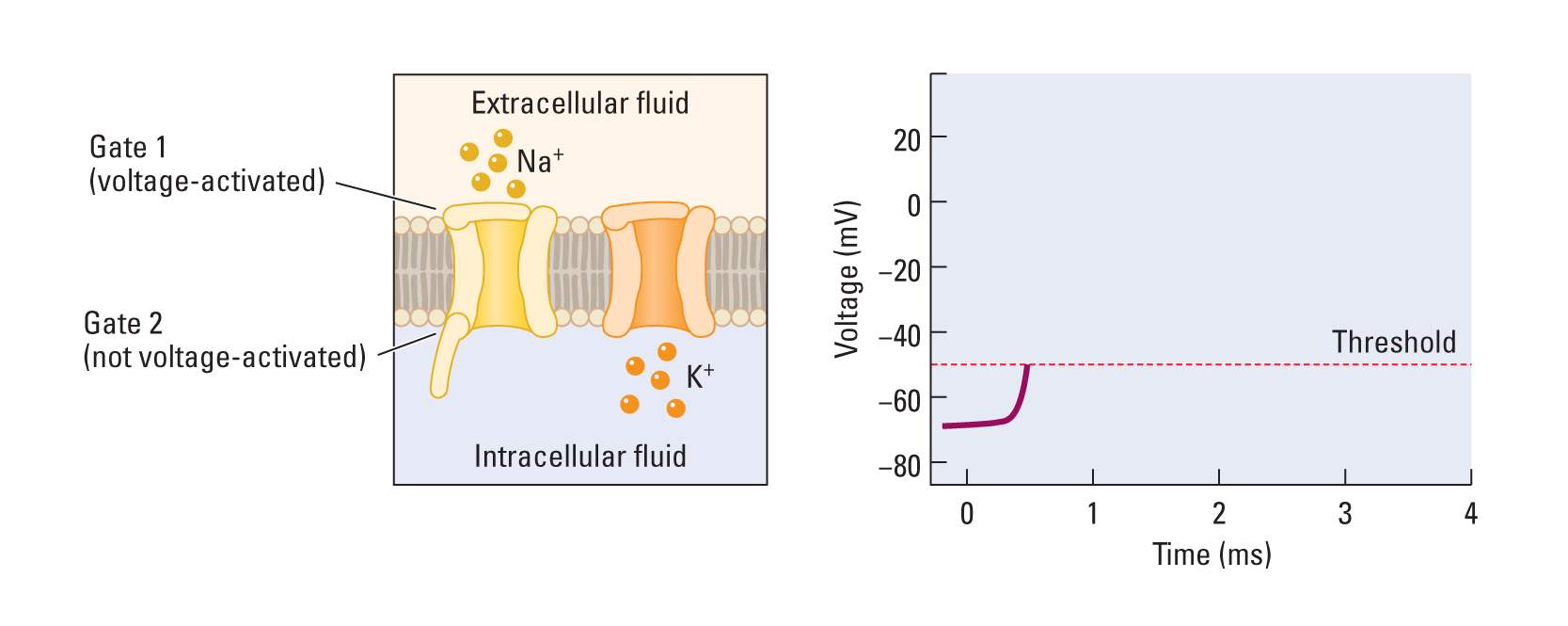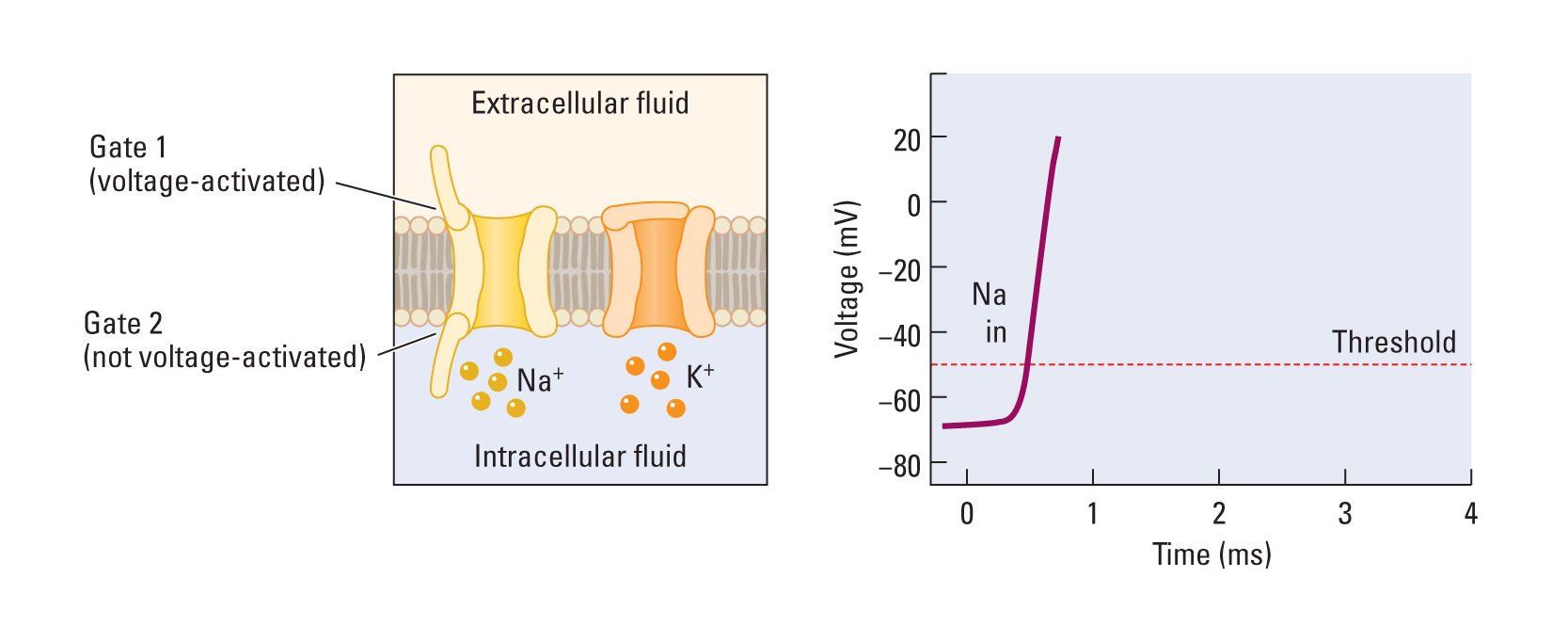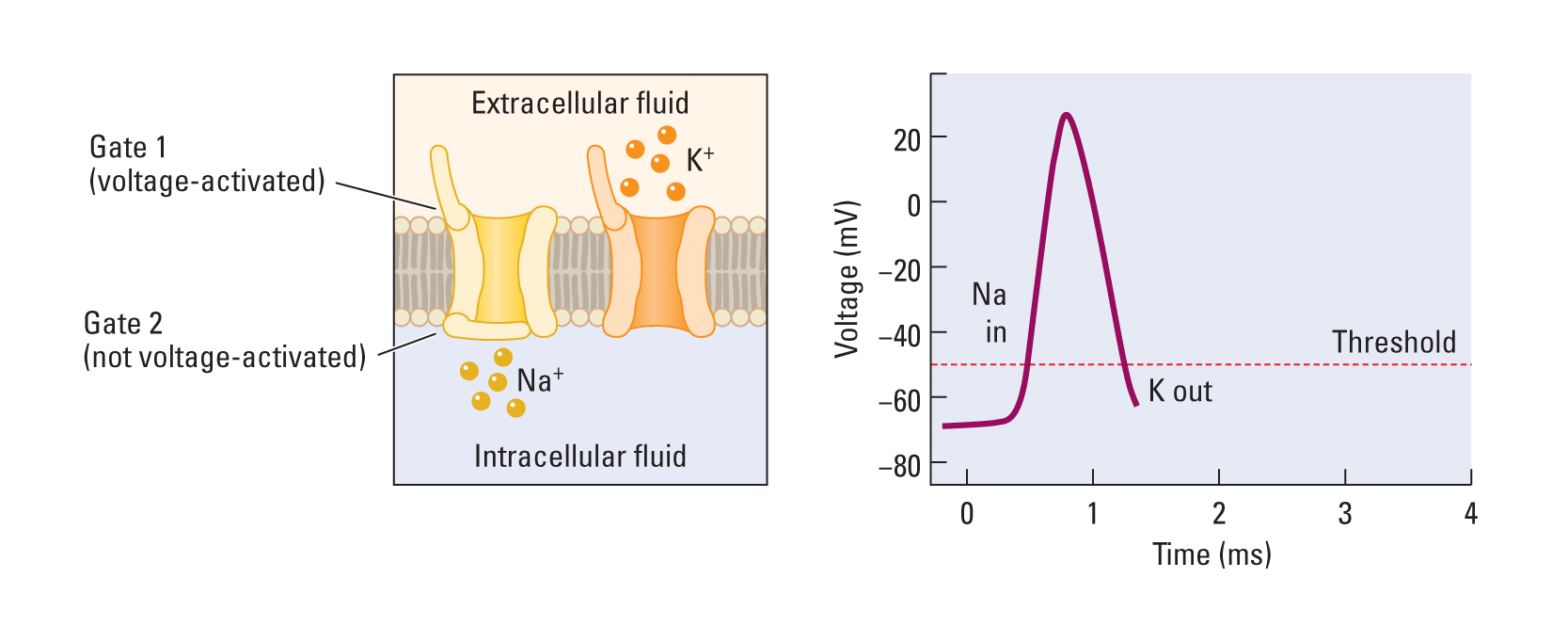Chapter 1. Neuronal Activity: Understanding Potential
1.0.1 Neuronal Activity: Understanding Potential
Understanding Resting Membrane and Action Potentials
By: Dr. Aileen M. Bailey, St. Mary’s College of Maryland
1.1 Neuronal Activity: Understanding Potential
In this activity you will learn about the neuronal resting membrane potential and the action potential, as well as the factors that influence both of these processes. By the end, you will understand how neurons generate electrical signals to begin the process of neuronal communication.
After completing this activity, you should be able to:
- Describe how concentration gradients and voltage gradients influence the resting membrane potential.
- Explain how ion movement produces hyperpolarizing or depolarizing graded potentials.
- Explain how voltage-activated Na+ and voltage-activated K+ channels produce action potentials.
- Predict how ion movement influences graded potentials and action potentials.
This activity relates to the following principles of nervous system function:
- Principle 10: The Nervous System Works by Juxtaposing Excitation and Inhibition
1.2 The Resting Membrane Potential: Concentration Gradients
A neuron's resting potential is the electrical charge across a resting cell membrane that stores potential energy. This potential is altered by the movement of charged particles, called ions, across the membrane. There are two main factors that influence ion movement within cells: concentration gradients and voltage gradients.
Concentration gradients are based on the difference in relative abundance (or concentration) of a substance along regions of the cell membrane: A substance will diffuse, or move, from an area of higher concentration to an area of lower concentration.

Question 1.1
HxLp/pubAQNkn0OW9nnOsec0alCedYhEnYhcOjJtrrqvvSTXGQySNQHOmLvmr2knETHekXcDzaU0+Za8NecKKk7Yu/+yK921uHQW/fm+zyD4LvI8RYhaAcoja3wuF3RO4+FGM7r0G86yDdrDtu2V8xFeSnLiA4XCSUaoVYPnrkJQ2QOqIPqAKpPTCX37h2enUe1AMUBIljj1v4o4IvnbecgBi9qasWzHJ8T1sjbozXrmbzNnnf6/wYxpSaBjc8cUi2j/srn+NyJxzNzDwCmnVPi/8BBOoovc7mQ7fWyhajy6BeWsY218ibNzvIAK0NwrcxPRy1CsTKx5zKUnLwOsjSnK9zJsjT/+lQ53A3r9NRxF1OXWOFNj426SklCAekPXDrZU2XZM6vGtXodvK6Ic4dU21sU5Yo0rP1MplCPWxjFVSfj1qXl0NkZC8K7GBcVpXCLHyiiVtsr/ZNV3T/O9PLSIxf5RMcDHyfc96QZJF9CCTH6sKDRaEQ==Your answer has been provisionally accepted. You'll get full credit for now, but your instructor may update your grade later after evaluating it.

1.3 The Resting Membrane Potential: Voltage Gradients
The second factor influencing ion movement is the voltage gradient. The voltage gradient is based on the difference in charge between two regions and, because like charges repel one another, ions will move from an area of higher charge to an area of lower charge and vice versa. For example, negatively charged ions will follow a voltage gradient to an area with a higher (positive) charge.

Question 1.2
p+qdDCePUQsaFW4UoeFWnJTGGGGtRsLS9gPx1iXSGDgiHTeJp1vmtzCOPW4hHyh7QYN4D1flyxUyrETOo4qKIhrhmblPQjJlevBdskQXawTb1EqrXXgvNgJfb+SFjHB3FAk3iJ+TybTP6tr4z3an64I7pIZwaS24twAORUepeabHT5zKHmszq52zaoNtzXPaxgP42MZt3zp4sPPuMgpb9+yctEv2DhhhPO2j4Qsj7+X2/tCBqJrkQHKLKkKnjZKUNpCFQ9V5zMc5bWgdNxKXSwoZjFgONkVYeU0dMVc3UTrGBcPH2+E1h9HuVbp5fgIwtIUq68FfJjSmtRZGrwDyWTp4dME=Your answer has been provisionally accepted. You'll get full credit for now, but your instructor may update your grade later after evaluating it.

1.4 Graded Potentials
Four ions are involved in changes in resting membrane potentials, known as graded and action potentials: potassium (K+), sodium (Na+), chloride (Cl-), and large negatively charged protein ions (A-).
Graded potentials are small voltage fluctuations across the cell membrane. They can be created by the movement of these ions between the intracellular and extracellular space.
A hyperpolarizing graded potential is an increase in electrical potential: the membrane potential is moving from a lesser charge (mV) difference to a greater charge difference (farther away from zero) making the cell more negative due to the movement of K+ ions out of the cell or Cl- ions into the cell.
In contrast, a depolarizing graded potential is a decrease in electrical potential across the membrane: the membrane potential is moving from a greater charge difference to a lower charge difference (closer to zero) making the cell less negative due to the movement of Na+ ions into the cell.
Select an ion to see the influence on graded potentials. Note the corresponding change to the meter reading (S represents the point at which enough ions have moved to change the resting membrane potential). You must select all of the ions before you move on. The Continue button will appear after all 3 videos have been played.
1.5 Threshold Potentials
The movement of K+ and Na+ ions creates an action potential, which is a brief but large reversal in the polarity (charge) of an axon’s membrane generated from changes in ion concentrations, concentration and voltage gradients, and voltage-activated channels located on the cell membrane wall. Everything that you do, perceive, or think is completed in units of action potentials.
At resting membrane potential (-70 mV), the voltage-activated K+ channel is closed, and K+ ions do not move through that channel. The voltage-activated Na+ channel has two gates, one that is open at resting membrane potential (Gate 2) and one that is closed at resting membrane potential (Gate 1). When the electrical potential of the neuron depolarizes to -50 mV, the membrane is at threshold potential. At threshold, the K+ voltage-gated channel and Gate 1 of the voltage-activated Na+ channel open.

Question
2i0u9IM+wZLzXkTKEt09Tqfabw52S8b6qtnbv96iAY/7Z1Y8LUY2F8DQ6Nn89fYRbOOMNPK2g3EQiWVFdUyTv23Px+h+vpqPUDAiXJWSPo7+FnBEcJ9kvVXXyeP7qhj9bHzufXokUNsT29IPyTa6eAgiCN69rjarTESe0IzK65Cwjg9zj8TFmEgdptJLYvFC2qBnunWZTVNNhtXAWtEEnAw3Yr8Ewo0JJEUb5S/v+k6aO3OTqv7EZQONljFIGTuKKISMUUHktaZbVwgz/e5Wr4ZGOFfFMALRL4cdwCh5R+j+WR3D4UTD0m6cT6l/jbR+L4u0eOC3UX/dn8J9UToUBjDdGOb6ZkmSgjvId+1bVq3MPHFgHHmvCVWqnubKnv8ESN96nmqwCJ0xJqXVFS1JQW491V6miCaSCnbX/zKeHF3LuoaireGVCI95mDcxF2+GI4s1/VSf/eMq3S8lt+/5+xpdZVoLgt6khClSYPTlbsy0CWpRoez7vwyLmofnnzK+vdDCg5LcWlXf0S1z6f6x6dxL+kMoW9TwXDwCNfguxzGv9YZ438WeXAmXRQB7ErlCk7kREg==
1.6 Action Potentials
Voltage-activated Na+ channels open when threshold potential is reached, but so do K+ voltage-activated channels. However, the Na+ channels are faster at opening, and thus the Na+ ion movement from the extracellular to the intracellular space occurs more rapidly, resulting in a large initial depolarization. K+ voltage-activated channels are slower to open, but are generally open at the peak of the action potential (approximately +20 mV). Gate 2 of the voltage-activated Na+ channel closes at the peak of the action potential and, thus, Na+ ions no longer cross the membrane. The electrical potential inside the neuron at the peak of the action potential is now positive, and the neuron contains an abundance of Na+ ions.

Question
bqtd1kuy5MCAC+GeV7BFTZGSJg2oaScXIgEQfd1cvNCG6kmcfmWG0YA1c7kfScD246oJq2BOgeq13YFqp4mJUlQk3k0ixZLra3bCwKfuBE7BQucTjCHr9fs+gMmeBrZ1fVhDFat01iGE3XXZt+hmEVqIoJj7c8luMqhIyRAuvo7AaY5sMKGnNW/ycmPfoI/Fb+NDMcYlJG36bvGC61yOGeg2JyNO2QWcjyGKf4pw52kCU2jPiimJj+bDGldzau44Izl64pubG2SXuCraM1kmes7IiuoDyCf/9yfYboQHMQke7Q8JYfi7Wh6d26dARmyaoMr78v7sM9FW0WR36UolfRQBl6xY046WyP53rNSdelTfpeVAKP5VcIH0nn8Mwucw4gtALH54oDwDboj0hfE/hVgWP1pFiHNG5Bwonv6TfdYxzb09BOqoyZ4lFwnqi14jqIZKUWln0AWoQI30+Vp8qywtNX0=Voltage-activated K+ channels are slow to open and slow to close. Because voltage-activated K+ channels are slow to close, the outward flow of K+ continues and the neuron hyperpolarizes. When the voltage-activated K+ channel eventually closes, the Na+/K+ pump returns the concentration of Na+ and K+ ions to their original state.

1.7 Summary
Congratulations! You have completed the activity. In this activity, you made predictions regarding resting membrane potentials, graded potentials, and action potentials. You also reviewed how the concentration gradient and voltage gradients of important ions (K+, Na+, and Cl-) in the cellular space influence the membrane potential of a neuron. This material is the basis for how neurons use electrical signals to begin the process of neuronal communication.
Your instructor may now have you take a short quiz about this activity. Good luck!